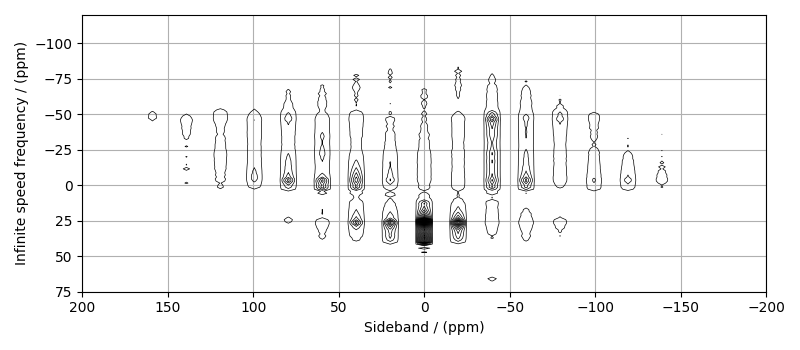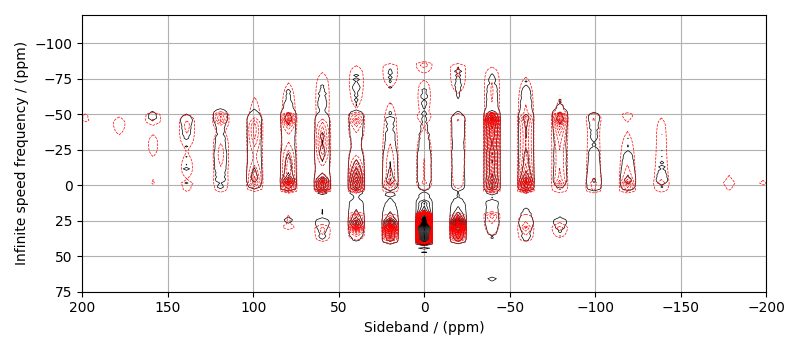Note
Click here to download the full example code
⁸⁷Rb 2D QMAT NMR of Rb₂SO₄¶
The following is an illustration for fitting 2D QMAT/QPASS datasets. The example dataset is a \(^{87}\text{Rb}\) 2D QMAT spectrum of \(\text{Rb}_2\text{SO}_4\) from Walder et al. [1]
import numpy as np
import csdmpy as cp
import matplotlib.pyplot as plt
from lmfit import Minimizer
from mrsimulator import Simulator, SpinSystem, Site
from mrsimulator.method.lib import SSB2D
from mrsimulator import signal_processor as sp
from mrsimulator.utils import spectral_fitting as sf
from mrsimulator.utils import get_spectral_dimensions
from mrsimulator.spin_system.tensors import SymmetricTensor
Import the dataset¶
filename = "https://ssnmr.org/sites/default/files/mrsimulator/Rb2SO4_QMAT.csdf"
qmat_dataset = cp.load(filename)
# standard deviation of noise from the dataset
sigma = 6.530634
# For the spectral fitting, we only focus on the real part of the complex dataset.
qmat_dataset = qmat_dataset.real
# Convert the coordinates along each dimension from Hz to ppm.
_ = [item.to("ppm", "nmr_frequency_ratio") for item in qmat_dataset.dimensions]
# plot of the dataset.
max_amp = qmat_dataset.max()
levels = (np.arange(31) + 0.15) * max_amp / 32 # contours are drawn at these levels.
options = dict(levels=levels, alpha=1, linewidths=0.5) # plot options
plt.figure(figsize=(8, 3.5))
ax = plt.subplot(projection="csdm")
ax.contour(qmat_dataset.T, colors="k", **options)
ax.set_xlim(200, -200)
ax.set_ylim(75, -120)
plt.grid()
plt.tight_layout()
plt.show()

Create a fitting model¶
Guess model
Create a guess list of spin systems.
Rb_1 = Site(
isotope="87Rb",
isotropic_chemical_shift=16, # in ppm
quadrupolar=SymmetricTensor(Cq=5.3e6, eta=0.1), # Cq in Hz
)
Rb_2 = Site(
isotope="87Rb",
isotropic_chemical_shift=40, # in ppm
quadrupolar=SymmetricTensor(Cq=2.2e6, eta=0.95), # Cq in Hz
)
spin_systems = [SpinSystem(sites=[s]) for s in [Rb_1, Rb_2]]
Method
Create the SSB2D method.
# Get the spectral dimension parameters from the experiment.
spectral_dims = get_spectral_dimensions(qmat_dataset)
PASS = SSB2D(
channels=["87Rb"],
magnetic_flux_density=9.395, # in T
rotor_frequency=2604, # in Hz
spectral_dimensions=spectral_dims,
experiment=qmat_dataset, # add the measurement to the method.
)
# Optimize the script by pre-setting the transition pathways for each spin system from
# the method.
for sys in spin_systems:
sys.transition_pathways = PASS.get_transition_pathways(sys)
Guess Spectrum
# Simulation
# ----------
sim = Simulator(spin_systems=spin_systems, methods=[PASS])
sim.run()
# Post Simulation Processing
# --------------------------
processor = sp.SignalProcessor(
operations=[
# Lorentzian convolution along the isotropic dimensions.
sp.FFT(dim_index=0),
sp.apodization.Gaussian(FWHM="100 Hz"),
sp.IFFT(dim_index=0),
sp.Scale(factor=1e4),
]
)
processed_dataset = processor.apply_operations(dataset=sim.methods[0].simulation).real
# Plot of the guess Spectrum
# --------------------------
plt.figure(figsize=(8, 3.5))
ax = plt.subplot(projection="csdm")
ax.contour(qmat_dataset.T, colors="k", **options)
ax.contour(processed_dataset.T, colors="r", linestyles="--", **options)
ax.set_xlim(200, -200)
ax.set_ylim(75, -120)
plt.grid()
plt.tight_layout()
plt.show()

Least-squares minimization with LMFIT¶
Use the make_LMFIT_params() for a quick
setup of the fitting parameters.
params = sf.make_LMFIT_params(sim, processor)
params["SP_0_operation_1_Gaussian_FWHM"].min = 0
print(params.pretty_print(columns=["value", "min", "max", "vary", "expr"]))
Out:
Name Value Min Max Vary Expr
SP_0_operation_1_Gaussian_FWHM 100 0 inf True None
SP_0_operation_3_Scale_factor 1e+04 -inf inf True None
sys_0_abundance 50 0 100 True None
sys_0_site_0_isotropic_chemical_shift 16 -inf inf True None
sys_0_site_0_quadrupolar_Cq 5.3e+06 -inf inf True None
sys_0_site_0_quadrupolar_eta 0.1 0 1 True None
sys_1_abundance 50 0 100 False 100-sys_0_abundance
sys_1_site_0_isotropic_chemical_shift 40 -inf inf True None
sys_1_site_0_quadrupolar_Cq 2.2e+06 -inf inf True None
sys_1_site_0_quadrupolar_eta 0.95 0 1 True None
None
Solve the minimizer using LMFIT
minner = Minimizer(sf.LMFIT_min_function, params, fcn_args=(sim, processor, sigma))
result = minner.minimize()
result
The best fit solution¶
best_fit = sf.bestfit(sim, processor)[0].real
# Plot of the best fit solution
plt.figure(figsize=(8, 3.5))
ax = plt.subplot(projection="csdm")
ax.contour(qmat_dataset.T, colors="k", **options)
ax.contour(best_fit.T, colors="r", linestyles="--", **options)
ax.set_xlim(200, -200)
ax.set_ylim(75, -120)
plt.grid()
plt.tight_layout()
plt.show()

Total running time of the script: ( 0 minutes 9.262 seconds)
